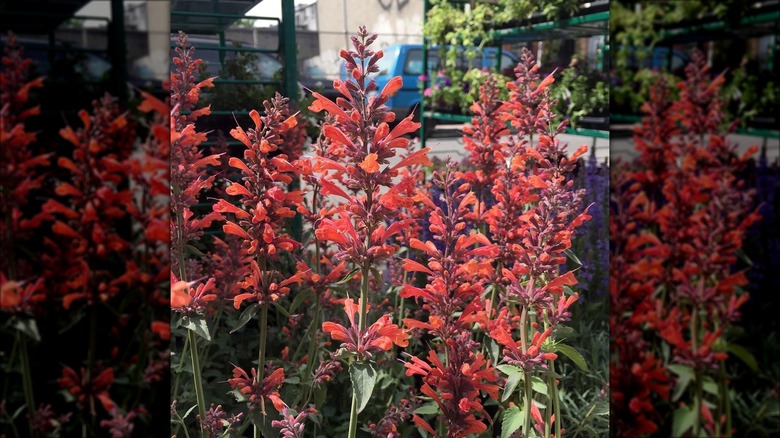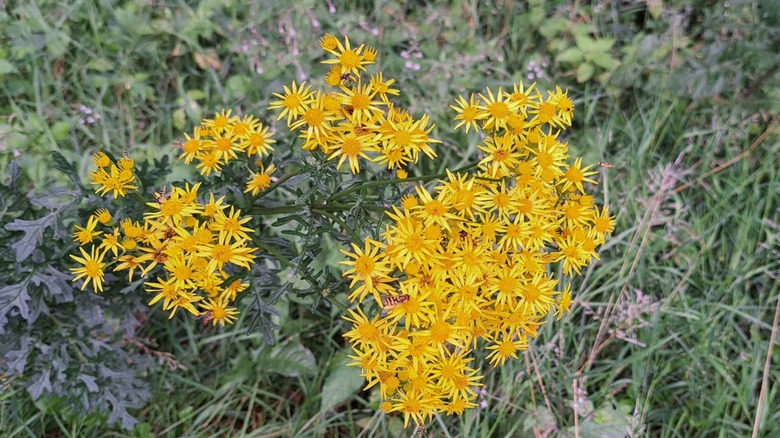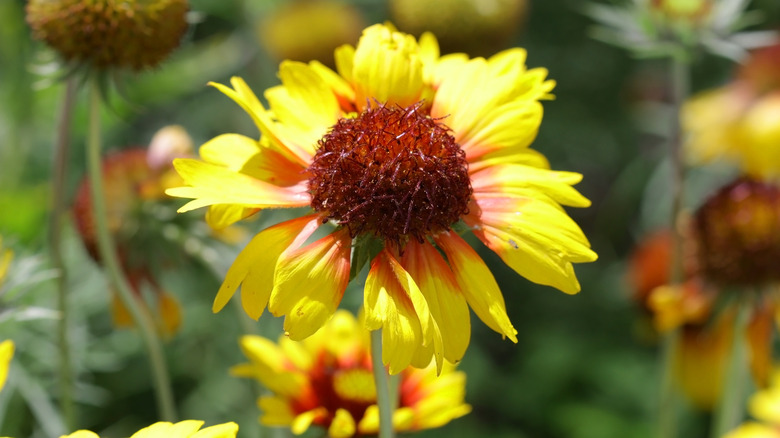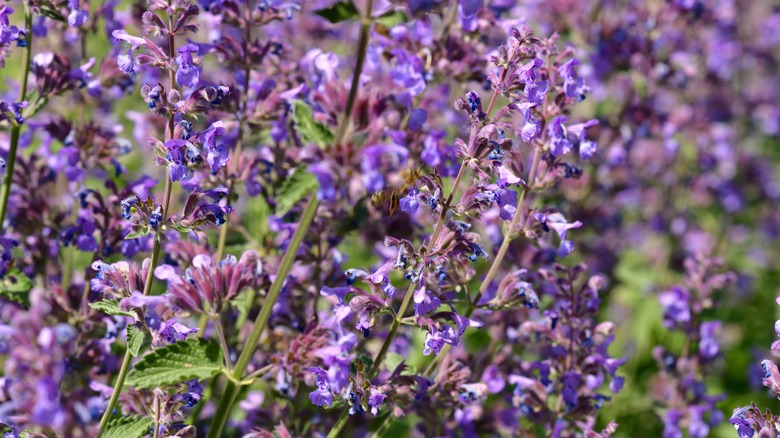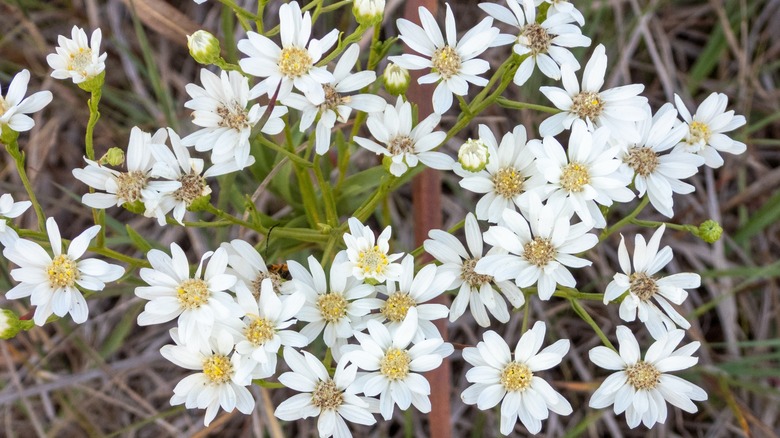The 25 Best Plants To Grow In Shallow Soil
Many a dream apropos basking in a handsome garden die at the existence of shallow soils. This soil type doesn't make way for your shovels or plant roots, insipidly drinking away the water you pour onto it. By this time, you might've resigned yourself to shaping a raised bed to enjoy a bare semblance of greenery. Or, perhaps, you're astutely experimental, and have resorted to hewing off a third of your chosen plant's roots to force it to grow in shallow soil. However, these measures become tedious to chart over time, inspiring the necessity to research plants that are content in shallow soil depths.
So, to ease your process (and put you out of your misery), below we've rounded up a list of the best plants to grow in shallow soils, all of which are gorgeous, drought-resistant, pollinator- and pet-friendly, safe around curious kids, and not invasive. However, beware, not all of these plants will behave equally well in your yard. That's because "shallow" is a spectrum, where a depth of under 10 inches doesn't cut it for the hardiest of plants, though most will settle for 20 inches. Looking for nursery plants potted in shallow containers will usually give you a head start, as will looking for fibrous-rooted annuals, herbaceous perennials, or turfgrass.
Giant hyssop 'Acapulco Orange'
Its tubular flowers may be orange, but giant hyssop (Agastache 'Acapulco Orange') is golden in rock gardens and xeric landscapes with poor, shallow soils. It not just tolerates, but rather prefers lean substrates, and would happily grow in gravel if it had its way — clay soils are a no-go, though. This stands true even when this deer-resistant hybrid cultivar is exposed to the sun on full blast and receives occasional watering throughout its spring-through-frost flowering period. It may be short, staying under 2 feet at maturity, but it attracts a bevy of hummingbirds and pollinators.
Coastal serviceberry
Endemic in dry and barren pine woodlands of the eastern U.S., coastal serviceberry (Amelanchier obovalis) has made a headway into home gardens due to its knack to attract more songbirds and bees with its white flowers and red berries. However, this drought-resistant plant makes a stellar addition to shallow-soiled gardens as well, provided the base is acidic and receives its fair share of sunlight. Coastal serviceberries can grow over 3 feet tall and wide, so it will require ample space. Bear in mind, they send across stolons, meaning they'll take over the garden eventually when left to their devices.
Plantain pussytoes
Cat people may quite enjoy plantain pussytoes (Antennaria plantaginifolia) for its spring-blooming, pink-tinged white flowers that cluster like a feline's toes — though without putting off the birds or butterflies. Usually staying between 4 and 6 inches tall, plantain pussytoes is best grown as a groundcover, as it adores creeping along the ground in a dense patch, especially when the soils are lean and infertile. It's also pest- and disease-resistant. But some may be put off by its short flowering period. While it supports a semi-evergreen mien through most parts of its eastern U.S. range, it tends to decline over time.
Common bearberry
Neither bears nor you, with your lean, dry soils that closely match its natural home in sandhills and stony landscapes, can resist the charms of common bearberry (Arctostaphylos uva-ursi). Incubating green berries that turn red during the winter, contrasting beautifully against its leathery green foliage, bearberry brings in the festive mood even for birds and small mammals who would otherwise go hungry. Grow it as a neat groundcover in USDA zones 3 through 7, and enjoy the hummingbird-dotted white urn-shaped flowers all spring. Don't pop the perennial without meriting its requirements, as it despises transplantation and deep shade.
Heath aster
Native to the central and eastern U.S., heath aster (Aster ericoides) is another herbaceous perennial worthy of a spot in your garden. Besides contentedly acceding to shallow soils, the generally mildew-, disease-, and pest-resistant plant brightens up the landscape with its daisy-esque flowers when your summer garden is standing on its last legs. This routine lasts through autumn — a fact that isn't lost on myriad butterflies, moths, bees, and unfortunately, deer and rabbits, too. Spreading 1½ feet wide and twice as tall, heath aster works as an accent or massed in drifts.
Lanceleaf coreopsis
Want a gorgeous plant that furthers your quest to make your own birdseed and also covers up your yard's shallow dirt? Lanceleaf coreopsis (Coreopsis lanceolata) is up for grabs. Also called tickseed, coreopsis ushers in spring with its yellow disk flowers, often dotted by bees and butterflies. Come summer, the fast-growing perennial sets its bird-attracting seeds that — although don't adhere to the gardener's shins — are inclined to self-sowing. So, either remove the dead blooms to keep the plant contained or allow it to naturalize. Separate the clumps every couple of years to maintain plant vigor.
Narrow leaf coneflower
At home in the sandy-rocky soils of the central U.S., narrow leaf coneflower (Echinacea angustifolia) is the perennial to plant when you're dealing with the triple whammy of drought, poor fertility, and deer browsing. It stays under 2 feet on top and across, and is well-liked by specialized bees, butterflies, and native pollinators for its copper-eyed, rose-purple flowers dripping with sweet, summer nectar. You'll also find goldfinches huddling around the plants, provided you haven't sheared the growth to fit your aesthetics. However, be wary of the common pests that are after your coneflower, especially Japanese beetles.
Robin's plantain
Predisposed to flourish in moderate or dappled shade, robin's plantain (Erigeron pulchellus) is another low-growing, easy-maintenance herbaceous perennial that's often grown as a groundcover in lean soils. Despite the washed-out lilac shade, its ray flowers look quite attractive to both its growers and the horde of bees, butterflies, and birds. Although native across the eastern U.S. region, Robin's plantain can get aggressive, profusely propagating via its seeds and stolons, and so must be pruned and divided regularly to keep it under control. Growing it in amended, fertile soils may also impede growth. Mass plant for a natural look.
White wood aster
Poor soils, heavy shade, and shallow soils can't put a damper on the exuberant excellence of white wood aster (Eurybia divaricate) gracing your fall gardens with yellow-disked, white flowers. Once pollination is through, the yellow disks transmute into fiery reds, making for tasty fruits nibbled on by birds through the winter. Good drainage and air flow are essential, as the fast grower is disposed to contracting foliar diseases, especially powdery mildew. In small spaces, trim the growth to ½ feet before summer begins to avoid overwhelm.
Threadleaf coreopsis
Imbuing your spring-summer landscape with pollinator-friendly golden blooms, threadleaf coreopsis (Coreopsis verticillate) is a must-have perennial in partially-shaded, west-facing sites. It has plenty of other qualities, including (but not limited to) impressive endurance for drought, salt, infertility, and herbivory, with a preference for rocky sites being foremost. The otherwise low-maintenance plant can grow over 2 feet tall and must be deadheaded to encourage re-blooming and to check its self-seeding. Or, you can grow its sterile cultivars, like 'Moonbeam,' that spread laterally to do away with its assertive tendencies. Popular with beneficial insects, too.
Lanceleaf blanket flower
To bribe butterflies, honeybees, hummingbirds, songbirds, and beneficial wasps into extending their stay in your backyard as the summer cusps into fall, grow lanceleaf blanket flower (Gaillardia aestivalis). This low-maintenance, south-central U.S. native's brownish-orange centers explode into nectar-heavy buttery petals for most of the growth season, enlivening any sandy or rocky sites. Given full sun, its grayish-green, toothed mound hoists itself over 1 foot tall and similarly wide. However, as they usually persist only for short durations, it's best to leave some spent blooms to sprout new seeds, so that the wind-pollinated plant returns to the yard.
Globe gilia
Highly adaptive, globe gilia (Gilia capitata) is a beautiful plant that will thrive in clay soils, as well as shallow rocky soils swathing your yard, albeit good drainage is key. That's why it's so prominent across wildflower mixes, particularly in the western U.S., where the annual hails from. Globe gilias keep the landscape busy with myriad bees and pollinators frenzying around its five-petaled, bluish-violet flowers packed into a globular shape (in line with their name). Unless plonked in overcrowded beds where resource competition inhibits their growth, these wildflowers will dispense their seeds without turning weedy, ensuring their comeback.
American ipecac
A partially shaded or dappled site, especially during sizzling noons, and fine-draining rocky soils provide the perfect conditions for American ipecac or Indian physic (Gillenia stipulate) to flourish. It doesn't hurt the eastern U.S. native sprouts gorgeous, trifoliate leaves, becoming the highlight of fall when they turn red, matching the burgundy stem base they're balancing on. Moreover, its stellate white blooms are amply popular with pollinators and songbirds, making it standout as a border background. While the 3-foot-tall ipecacs extend their presence by shooting rhizomes, they only establish at surface levels. Slugs may pose problems.
Heart-leaf hibiscus
Going by several names, including heartleaf rosemallow and tulipan del monte (quite fitting given the crimson red flowers), heart-leaf hibiscus (Hibiscus martianus) is an easy-to-grow perennial for shallow soils (including gravel and caliche). Originating in Texas, this colorful variety of hibiscus flowers is only hardy in USDA zone 8, with full-to-part sun and good drainage being non-negotiables. Once its conditions are met, it draws the attention of diverse hummingbirds, butterflies, and native pollinators with its saucer flowers dancing atop the 3-foot, heart-leaved clump — sometimes throughout the year if the area remains frost-free. Deadhead the plant to induce continuous flushes.
Round-headed bush clover
Shallow soils are no excuse to sidestep plants you should have in your garden to naturally enrich the soil, like the nitrogen-fixing round-headed bush clover (Lespedeza capitata). Cousins to beans, bush flowers naturalize in a sunny location, magnifying its wildlife value by attracting a horde of butterflies, birds, and pollinators who gravitate to its cloud of magenta-spattered white or yellow flowers and copper fruit that braves the winter chill. Moreover, they demonstrate enviable endurance against most pests and diseases. However, pinching the faded flowers off is necessary to curb their spread, or the seeds will self-sow.
Devil's bite
One of the beautiful varieties of blazing star that hummingbirds will love in your garden, and that also don't turn grouchy about the soil's poor depth and texture, is devil's bite or blazing star (Liatris scariosa). It lends Midwest and eastern U.S.-based gardens mid-summer interest through its lavender (occasionally pink or white) flower spikes, building its following among playful butterflies and bees. Songbirds will alight on their nearly 4-foot-tall clump — which often requires staking — during the winter when other food sources are scarce. Barring infrequent nematodes, pests aren't a concern. They are best grown with corms (bulbs), because seeds are slow to establish.
Blue catmint
Although a European import, blue catmint (Nepeta x faassenii), the fragrant lavender look-alike that can withstand harsher conditions, can be safely planted in your garden's shallow soils, because it's sterile and unlikely to turn hostile. Besides, it has numerous advantages, including enthusing your felines without causing injury, repulsing deer, and coloring your rock walls, garden beds, or patios violet from spring through summer. A mostly problem-free cultivar, the plant places high amongst the fast-growing ground covers that'll attract hummingbirds and pollinators to your yard. Grow the plant in partial to full sun, and divide when it grows unwieldy.
Black-eyed Susan
Black-eyed Susan or orange coneflowers (Rudbeckia fulgida) are gorgeous flowers to consider planting when you have no shade in your yard — and with rocky-shallow soils to boot. These 3-foot touching perennials behave as dutiful, seed-bearing evergreen groundcovers, delighting their growers and goldfinches in the winter. Butterflies dart to them for nectar when their profuse radial display is on during mid-summer. If not divided every couple of years, orange coneflowers may establish colonies via their offsets. Deadheading rouses re-blooming, while keeping self-seeding tendencies in check. Usually disease-resistant, the flowerheads may require stake support.
Blue sage
Optimum even around the shallow dirt sitting atop your septic field, blue sage (Salvia azurea) is another south-central U.S. native plant that's sure to be popular with butterflies and bumblebees. The two-lipped, sky-blue flowers serve as perfect landing pads with the upper lips hooding the drinking pollinators. They promise an extended blooming season that may go up to early winter in the southern states. Deer-resistant, blue sage requires late spring pruning to keep it compact. Stakes are necessary when it gains over 3 feet. Grow it in full sun, though it will endure in light shade.
Little bluestem
Little bluestem (Schizachyrium scoparium) is a deer-repellent, native ornamental grass you should consider for your yard situated in any of the 48 contiguous states. Keeping with its name, little bluestem grows silvery-blue foliage, adorned by purple inflorescence and myriad admiring pollinators in sultry summers. Best of all, it generates spectacular fall and winter interest (even for songbirds) by metamorphosing into balmy copper grass decked in purple seedheads. Although capable of growing up to 4 feet, the warm-season perennial is unlikely to reach such lengths in shallow, infertile soils. Annual winter pruning is a must to maintain plant vitality.
Sedum
If you're looking for the perfect ground cover for year-round color in your garden sheathed in shallow dirt, sedum, or stonecrop is perfect. Quick to establish and cold-tolerant across USDA zones 3 through 9, sedums are mostly planted for their fleshy foliage, though their pollinator-friendly, stellate flowers are a sight to behold, provided you've picked the one for you from its diverse rainbow range. Sedums are easy to grow and even easier to maintain when given ample sun. Slimy insects can be a bother. Nurseries usually carry hybrid varieties like 'Touchdown Teak,' a talented performer in gravelly soils.
Upland white goldenrod
Looking nothing like its yellow-flowered goldenrod brethren, upland white goldenrod (Solidago ptarmicoides) produces aster-like, creamy white flowers from late summer through fall that bees and butterflies appreciate. You can even attract more goldfinches to your yard, as they like its fall-appearing, silver puffy seedheads. However, you must deadhead some blooms, lest the perennial annexes adjacent land — fall pruning helps, too. In its central U.S. range, upland white goldenrod, or prairie aster is often found blooming in rocky, shallow, and limey soils and prefers such site conditions be imitated in gardens receiving full sun.
Wild pink
Growing around 1 foot tall and similarly wide, wild pink or Carolina campion (Silene caroliniana) is another low-maintenance, perennial wildflower that adapts to well-draining, shallow rocky soils. A multitude of hummingbirds, native bees, and nocturnal moths depend on its tubular pink flowers to ride them out in the waking days of spring. Hardy in the USDA zones 5 through 8, wild pink supports a semi-evergreen to evergreen, disease-free dense mat. Plonk it in the sunny site that receives some shade in the afternoon. Ants and deer stay away from its sticky foliage.
Caraway thyme
Hailing from Mediterranean Europe, but non-invasive in the U.S., caraway thyme (Thymus herba-barona) is a fragrant, gastronomic herb (often substituted for the caraway seed) suitable for growing in shallow, alkaline soils. It crawls wider than it grows tall, staying under 1 foot, and is best used as a groundcover in low-traffic areas or to embellish the area adjoining stepping stones. Evergreen in USDA zones 4 to 8, caraway thyme surprises butterflies and bees with nectar-rich, pink flowers in the summer. Be prepared to give the perennial regular haircuts; otherwise, it'll turn leggy, or worse, break free of its boundaries.
Prairie dropseed
A unique type of grass to plant in your yard that birds can't resist, but deer can, is prairie dropseed (Sporobolus heterolepis) and luckily, it flourishes in shallow-rocky soils. Native in central-to-western U.S. regions, this warm-season grass easily endures drought, pollution, black walnut, and foot traffic, making it a stellar addition to any yard. Above all, the 2-foot mound can be started with seed (without springing a self-seeding ornamental at your landscape) that will help your lawn break into a song once the aromatic pink blooms make way for delicious seeds that juncos adore.

